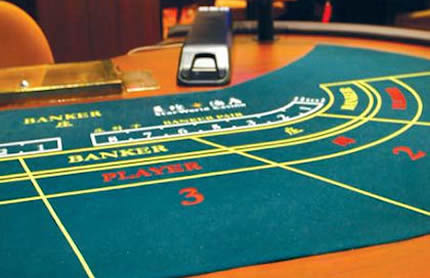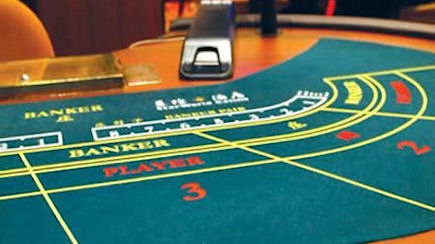This article first appeared in the Jan/Feb 2011 issue of World Gaming magazine.
In part A of this series, our tournament guru Andrew W Scott introduced you to general concepts of how to win a baccarat tournament. In part B, Andrew discusses how to know what stage of the tournament you are at.
Remember when playing a baccarat tournament your goal is not necessarily to win hands and chips. Your goal is to be ahead of your opposition when you cross the finish line! Yes, this can mean winning more than them, but it can also simply mean losing less. Money management, and focusing on your opposition, is crucial. In fact, it’s everything.
Be a star!
Let me introduce you to a very important piece of casino tournament terminology. It’s a word you will hear over and over in casino tournament strategy: ‘star’. If you are in the star position, you are in a position that if the game stopped right now, you have achieved your goal. If you are ‘not star’ or ‘outside star’, and the game stopped right now, you’ve failed. You should play to maximise your chance of being in the star position when the game ends (or as I like to say, ‘when the music stops’).
Here’s an example. Let’s say round 1 of a baccarat tournament has 12 players on each table, and each table will play one shoe of baccarat. At the end of the shoe, the top 6 players (that is the players with the six biggest stacks) will progress to round 2, and the other six players will be eliminated from the tournament. During (and at the end of) this round, the six biggest stacks are considered to be in ‘star position’, and the other stacks are ‘not star’.

Tournament structures
When I say ’round’, I could be referring to a heat or I could be referring to a semi-final or final.
Here is a very standard structure for a well-run baccarat tournament. Let’s say a tournament starts off with 72 players split into 6 tables of 12 players. That’s round 1. At the end of round 1, half the players (the top six from each round 1 table) make it through to three semi-finals. Each semi-final consists of 3 tables of 12 players (the 36 players who made it through from round 1). Now the top 4 players from each semi-final table make it through to the final (so only the top 4 are in ‘star position’ during, and at the end of, the semi-finals).
The final again consists of 12 players, the top 4 from each of the 3 semi-final tables. During the final, what is the star position? To be honest, usually only first place is considered star position because the prize for first is usually so much higher than the other prizes – so correct strategy is to go for broke and to try to win the tournament.
Typically each of these ’rounds’ (round 1, the semi-finals and the final) would consist of one 8-deck shoe of baccarat).
Your goal
Of course your goal is to be in star position when the music stops. In some tournaments this means trying to stay in star position all the way from the start line, but in most tournaments you actually maximise your chance of being in star position when the music stops by not worrying about whether you are star or not early in each round. Just as in a poker tournament you don’t have to be chip leader from the very start, it’s often ok to be ‘not star’ for a while in a baccarat tournament. You just need to know when to kick it out of cruise control, switch gears and go star-hunting. Knowing when to do that is all about understanding a tournament’s ‘stages’.
Stages
All rounds of a baccarat tournament have three quite clearly defined stages:
- The early going
- The middle going
- The late going (which I like to refer to as ‘the death’)
Let’s work backwards. The ‘death’ lasts only one hand, and it is the very last hand of the round. After that hand, all the chips will be counted and the winners determined. This is by far the most important hand of the round.

The exact start of the middle going depends a little on the relationship between the maximum bet, the average stack size, and the relative stack sizes between certain key players around the start of the middle going. It even depends a little on the ‘first bet’ marker position (see Part A for an explanation of the ‘first bet’ marker) and where that marker will likely be in relation to your position, at the death. Putting that all aside you are usually quite safe to say that the middle going starts with about ten hands to go in the round. If in doubt as to exactly when the middle going should start, err on the side of making the middle going last a little too long rather than a little too short. There is nothing worse than running out of time in a tournament. The middle going lasts until the penultimate (or second-last) hand of the round. This penultimate hand is by far the most important hand of the middle going.
The early going is simply everything before the middle going. In the highly unlikely event that a round lasts less than ten hands, there is no early going at all.
Strategies for each of these stages are very different, so it is crucial that you know what stage you are in. So how do you know how many hands there are to go? Good question!
Tracking hands
It is a little known fact that the average number of cards used in baccarat hand (if you want to be fancy you can call it a baccarat ‘coup’) is 4.94 cards. This number is very close to 5, which makes sense given that baccarat hands can only use 4, 5 or 6 cards. As an approximation, you can say that there will be 10 hands per deck of cards.
At the start of the shoe take careful notice of several things:
- How many decks are in the shoe.
- The precise location the dealer places the cut card to indicate the penultimate hand (this may be different to where the rules said the dealer was supposed to cut).
- How many cards are ‘burnt’ off the top of the shoe.
Some things to remember:
- Typically before play begins the dealer will burn (discard) one card off the top of the shoe and then as many more cards as the blackjack value of that first card, with ace counting as 1 not 11 (for example if the first card is a 5, he’ll burn five more cards, if the first card is a queen, he’ll burn ten more cards, if the first card is an ace, he’ll burn one more card).
- Unlike blackjack, when the cut card comes out in baccarat that usually means there will be one more hand – so you always definitely know when the last hand will be, but you may be a little unsure about which is the penultimate hand (until you are actually in it, by which time you have already placed your bets for that hand).
Using all this information you can estimate how many hands will be in the shoe, and count them down. Let’s do an example. Let’s say the round uses an eight-deck shoe – that’s 416 cards (or about 83 hands). We notice the dealer very carefully cutting about ten cards off the back (or 2 hands). The burn card is a king and the dealer burns a further ten cards off the top of the shoe (another 2 hands gone). Now we start to play. It’s a safe bet there will be 79 hands (give or take 1 or 2 hands) played before the cut card comes out. The first 69 will be the early going, the next 10 the middle going, and the last hand (after the cut card) is the death.
Of course you are supplied with pen and paper at a baccarat table! If you want to be really precise, instead of counting the hands played, you could actually mark off each individual card as it was dealt out! To be honest, this level of precision is not really necessary.
Now you have learnt how to know, at any given moment, precisely what stage of the tournament you are at: the early, middle or late going. Each of these stages call for a different strategy. We’ll begin discussing these strategies in part C of this series.







